Your cart is currently empty!
Frankenswitches
What is “Frankenswitching”?
The dark art of mixing different components from different switches together is known as “Frankenswitching”. These switches allow you to get even more custom than a custom keyboard already is by making something you can’t buy from any store.
Where did it all start?
Frankenswitching has been around for a long time, but it really started to get popular with the introduction of what is now known as the “Holy Panda”. The Holy Panda combines parts from Bsun and Invyr, making a switch that is super tactile, has a nice and sharp bottom out, and feels super smooth, even stock.
Since the Holy Panda really took the community by storm, there are many switches which have evolved from it, such as the Zyko, Byko, Holy Sheißio, and many more. Before I get too into them, first we need a small lesson on switch anatomy.
What makes a switch?
Materials
The material of a switch is super important for both the sound as well as the feeling. At the top and bottom out of switches, the stem hits the different parts, causing sound to resonate. While the stem is being pressed down, it will slide over different parts of the housing, causing friction which in bad cases can make what should be a smooth switch feel scratchy.
There are many different types of materials that are used in switches, and it is best to just look of the type for the switch you are interested in. Some popular materials are as follows, with some examples:
- Nylon & Nylon Blends (Used in Official Cherry MX Switches)
- Torlon (JWK Linears)
- Polycarbonate (Everglide Aqua King, Gateron Clear Top Housings)
- POM (POM Durock, NK_ Cream)
- UHMWPE (C3 Tangerines)
There are also many companies that do not disclose the exact blend of plastics uses in their switches. For example, Gateron Ink and ZealPC switches (all made by Gateron) feature an undisclosed blend which is similar to Polycarbonate, but also distinctly different in some ways.
Top Housing
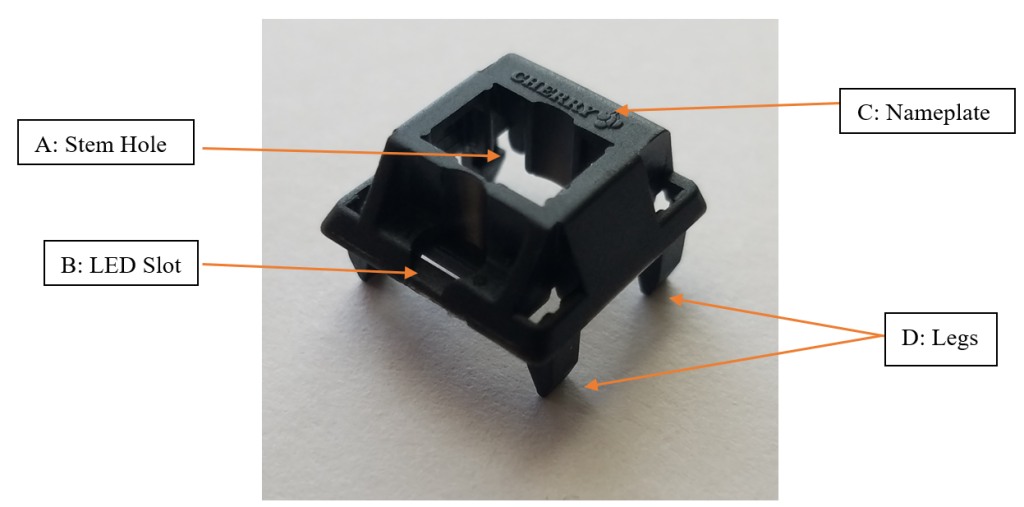
The top housing is what holds everything together. Being probably the least important part of frankenswitching, there are only a couple of important things to note here.
First, there are two “styles” of latching mechanisms, cherry and kailh. They are not interchangeable, so if you are thinking about ordering switches to try frankenswitching on your own, you need to make sure the top and bottom housing have the same latching mechanism
Second is that while most naïve people typically ignore using a different types of top and bottom housings, top housings contribute to the sound of a switch significantly. When the top of the stem returns to the resting position of the switch, it slams into the top housing, causing a noise which is very dependent on the type of material. Sometimes, like in the case of the Holy Sheißio, the choice of top housing is paramount to the overall sound.
Bottom Housing & Leaf
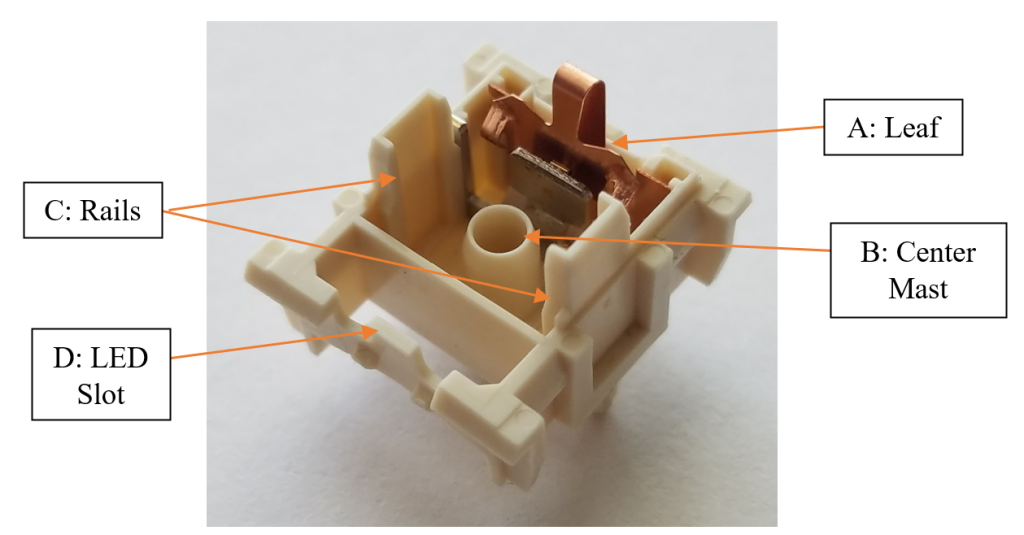
The bottom housing contributes a lot to the overall sound and feel of a switch. In terms of sound, there are two important things to note: the material and the depth of the center mast. If you bottom out your switches like most people do, the stem will end up hitting the bottom housing. This means that just like with the top housing, the material of the bottom housing contributes to the sound of the switch. The depth of the mast is important due to the potential variation in stem pole length, which I will get into shortly.
As for the feel of the switch, the important factors are the smoothness of the rails, the design of the leaf, and once again, the depth of the centre mast. The smoothness of the rails is something pretty simple, the smoother the finish of the plastic on the rails, the smoother the stem will move down, and the smoother the switch will feel.
The design of the leaf is somewhat complicated. The leaf is what actually makes the connection in the circuit, and as such the stem must move it. This means that the stiffness of the material used to make the leaf will cause either a smoother feeling for low stiffness (Linear) or a more tactile feeling with higher stiffness (Tactile). The smoothness of the contact point also matters, which can vary from manufacturer to manufacturer, and from switch to switch.
Stem
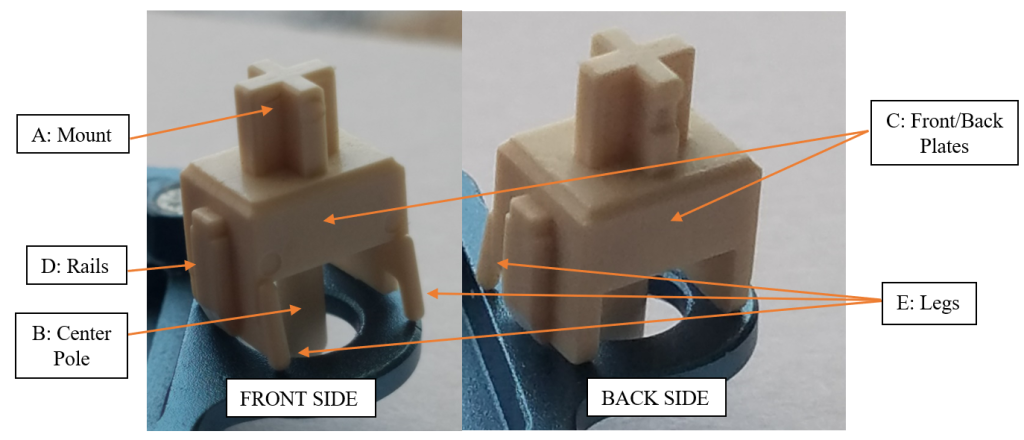
The stem contributes a substantial amount to the feeling and sound of the switch, much in the same way that the bottom housing does. The material of the stem will cause changes in both the top out and bottom out sound, as the stem is the main moving part in a switch.
The specific part of the stem that is most important are the legs. The design of the legs is where most of the smoothness or tactility come from in a switch. For a linear switch, a super smooth finish on the legs are paramount for a super smooth switch. For a tactile switch, the legs are where you will find the bump which causes the switch to be tactile. There are many different designs for this bump which vary heavily. There are rounded bumps which cause it to feel like you are pushing over a smooth hill, and there are sharp bumps which make it feel like you are pushing at a steep mountain.
What’s a Long Pole?
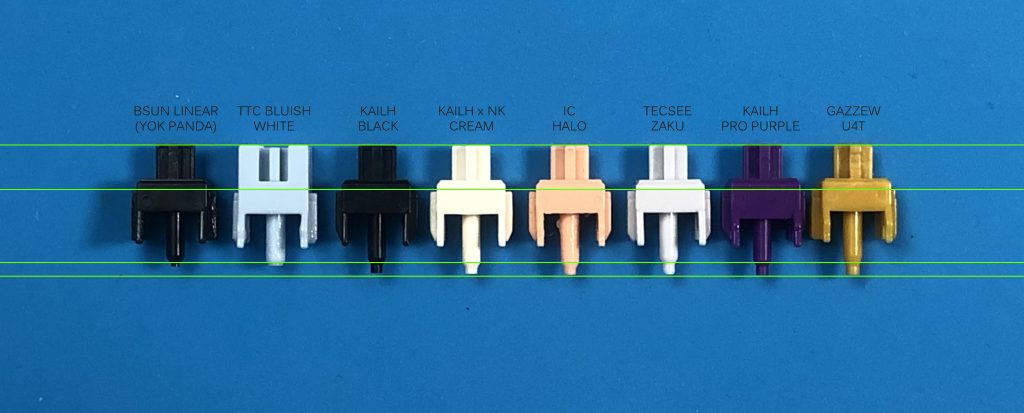
Another important part of the stem is the length of the pole. As can be seen in the image above, with each different stem there is a different pole length extending out the bottom. If you take a stem with a longer pole and put it into a bottom housing that does not have a matching depth centre mast, the bottom of the pole will hit the bottom housing before the centre part of the stem will, causing a faster and sharper bottom out feeling. This is very important in switches that are Holy Panda derivatives, which use the Halo stem shown above.
Some stock switches have even gotten on this trend, such as the Gazzew Boba U4T switch, which has an intentionally shorter depth center mast.
Spring
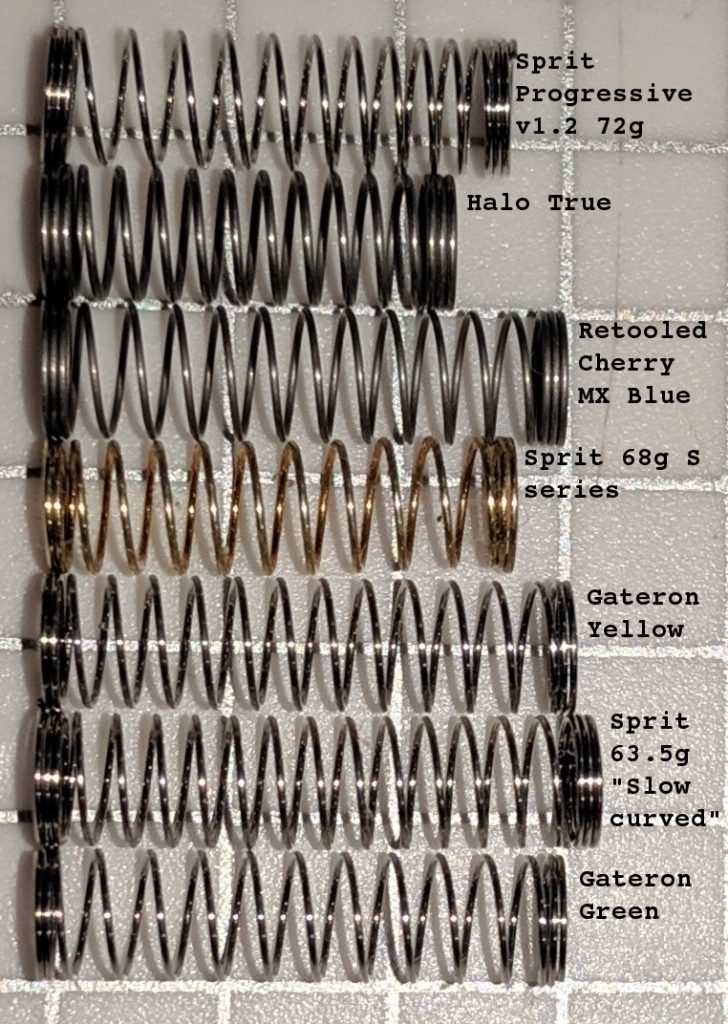
The spring is another often underrated part of frankenswitching, but can be very important in some switches, with the Holy Sheißio as a perfect example.
As can be seen in the image above, there are varying lengths, curl tightness’, and materials, all of which change the spring constant of any given spring. This spring constant, typically referred to as ‘k’ in physics, is one part in the fairly simple equation for force required to compress or extend a spring:

So, what does that mean for the switch feel? Well, different values of k, and different overall spring lengths will result in different amount of force being required to push down a switch. If you vary ‘x’ in this equation and plot the force value, you get a force curve for any given spring. These curves can often be found on the data sheet for any given switch.
By looking at these force curves and picking particular springs, you can make a switch feel noticeably different, especially in the realm of tactile switches. For the Holy Sheißio a long TX spring is used, resulting in a stronger feeling of resistance at the top of the travel, making the switch feel more tactile that with a standard length spring.
Popular Frankenswitches and their parts
Here comes the part where I start give a small list of popular frankenswitches. This is by absolutely no means an extensive list, and if you are really interested it’s worth doing some research on you own, or just going out and trying different combos!
Holy Panda
The big poppa of frankenswitches, the Holy Panda is made of an Invyr Tactile stem, and Bsun Top & Bottom housings. Well, that was how it was made originally. Since then the Bsun moulds have been lost, and the mould for the stems have been bought by Drop. Bsun, now known as YOK, have made a good replacement housing, as have Drop, allowing you to still make something close to a “real” Holy Panda. You can actually just buy Holy Pandas from Drop, however if you are just interested in the stem, it is contained inside the Halo true and the Halo clear, both sold by Drop. This is why the stem is more commonly referred to as the “halo” stem.
Holy Boba
The Holy Boba is similar to the Holy Panda. It uses the housing of a tactile Gazzew Boba switch (so either the U4 or the U4t), and putting the previously mentioned Halo stem inside it. The Holy Boba and the Boba U4t feel remarkably similar to be honest, and they both feel really good.
Zyko
It’s time to mix more than two switches! The Zyko is made by using a ZealPC Zealio or Zilent bottom, a Halo stem, and a Bsun/Yok top housing. This switch is widely regarded to be the even more tactile version of the Holy Panda with similar sound characteristics. One thing that is important to note when using ZealPC bottom housing is that it is very important to make sure the leaf does not move when you are assembling the frankenswitch. A good way of doing this is pre-applying a small amount of solder to the switch pins.
Byko
The Byko is almost the same as the Zyko, but instead of using a Bsun top housing, the top housing of a Boba switch is used. This results in a switch that is just like the Holy Boba, but just a bit more tactile due to how tactile ZealPC tactile bottoms are.
Holy Sheißio
Hands down my favourite tactile switch. It’s the only switch on this list where the spring is included in the standard build procedure, and it is actually a part that is easiest bought on its own. The Holy Sheißio uses a Cherry Nylon top housing, Halo stem, ZealPC tactile bottom housing, and either a Long TX spring or a Slow Curve Sprit spring. This results in a switch more tactile than any other you can find, as well as a beautiful sounding one to top it off.
Creamsicle
The Creamsicle is the combination of an Invyr linear stem, a C3 Tangerine bottom housing, and a NovelKeys_ Cream top housing. This switch is super tactile with a harsh bottom out and a very clacky sound, mostly due the UHMWPE bottom housing.
Creampaca
The Creampaca is made by combining a JWK Alpaca v1 housing with a NovelKeys_ Cream stem. The v1 housing is important as the top of a v2 housing does not have the correct tolerances, causing the switch to not return. In the case that you cannot find Alpaca v1 housings, the housing of a Durock Silent Linear will also sound almost the exact same (JWK and Durock are actually the same company!)
Black Cherry Pie
The Black Cherry Pie is a way to deal with the problems caused by the JWK Alpaca v2 moulds. Instead of using the top housing of an Alpaca, a Cherry Nylon top is used, resulting in a slightly different top out sound that many actually prefer. In fact, this is the favourite switch of Shoobs, who uses it for every spacebar he has.
Mock SP-Star Magical Girl
My favourite tactile switch, the magical girl (or dark magical girl) no longer exists for purchase! Fear not, there is a frankenswitch that is indistinguishable. You need the housing of SP-Star Meteor Oranges, and the spring and stem from SP-Star Polaris Purples to make it. They should sound and feel basically the exact same way.
